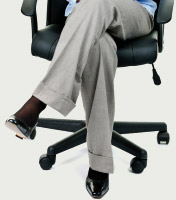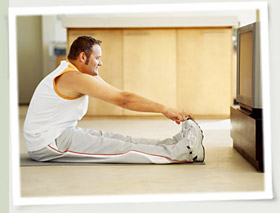
Health dangers of sitting all day at a desk, in a car or by the TV?
Posted in Health & Wellness on July 5, 2012. Last modified on April 15, 2020. Read disclaimer.
Our bodies were built to move -- to be running, climbing, swimming, hunting, building or gathering. Now that machines handle much of the "heavy work" for many of us, our hours of physical inactivity -- sitting at a desk, in the car, or on the couch -- we're becoming much more susceptible to a wide range of chronic health disorders that have been linked with leading a sedentary lifestyle.
According to the World Health Organization, approximately 2 million deaths per year can be attributed to physical inactivity alone and the problem is likely to get worse since almost two-thirds of children are also under-active.
Here are a few health problems associated with a sedentary lifestyle:
- Cardiovascular Disease: Heart disease is the leading cause of death for the population of the United States. Overweight individuals are twice as likely to have high blood pressure and high cholesterol. Heart attacks are significantly more common in the sedentary than the active population.
- Stroke: A stroke happens when lack of blood and oxygen to the brain causes paralysis and even death. A sedentary lifestyle increases risk of stroke by increasing its risk factors: high blood pressure, diabetes, obesity and alcohol and tobacco use. Stroke is the third leading cause of death in the United States.
- Type 2 Diabetes: Your body's ability to control insulin and bold sugar levels are impaired by this common disease. It is a major leading cause of death and other complications. A sedentary lifestyle leads to obesity which is a contributing cause of type 2 diabetes. Overweight individuals are twice as likely to develop diabetes. The percentage of those who have type 2 diabetes and are overweight is 80%. Physical activity has been shown to prevent insulin resistance, a precursor to type 2 diabetes.
- High Blood Pressure: According to the CDC, roughly one-third of all adult Americans have high blood pressure. A sedentary lifestyle has been shown to increase blood pressure. Untreated, it can lead to strokes, heart attacks, and kidney problems.
- Cancer: A sedentary lifestyle can indirectly promote cancer via being overweight. Being overweight has been shown to increase your likelihood of specific cancers including those of the colon, esophagus, and kidney. Obesity has been linked to uterine and breast cancers in post-menopausal women. One study found a 40% decrease in numerous cancers in those with an active lifestyle.
- Depression and Mood Disorders: Mood disorders have been shown to be more common in those with sedentary lifestyles. In addition, those who are sedentary are more likely to use and abuse alcohol and drugs.
- Cognitive Decline: Physical activity has been shown to reduce cognitive decline by up to 40% in older adults.
- Bone Loss: physical activity helps build muscle and prevents some bone loss as we age. A sedentary lifestyle means the muscles and bones are not getting the build-up they require to stay strong.
 Even if you get exercise during the week, if you spend the majority of your day sitting, you are still at risk for the effects of a sedentary lifestyle.
Even if you get exercise during the week, if you spend the majority of your day sitting, you are still at risk for the effects of a sedentary lifestyle.
The American College of Sports medicine says that the minimum recommended amount of physical exercise and movement for a week are not good enough if you spend the rest of the time sitting.
According to the studies if you work out every day but spend nine hours a day in front of a computer screen or on the couch, you may still be endangering your health. As a result, the ACSM is going to great lengths to overhaul their physical activity recommendations.
The University of Pittsburgh illustrates this in an interesting way: Carl and Kelly each meet the widely recognized goal of 30 minutes of physical activity a day, 5 days a week. During the rest of their time, however, Carl primarily tinkers on his car, works around the house or runs errands (light activities) while Kelly works at a desk all day and spends much of the evening in front of the computer or TV (sedentary activities). So, Kelly may best be described as an "active couch potato." And not are our "routine" activities important, so are the brief bursts of unplanned that a person would hardly think amount to anything. These mini breaks in our sedentary life may be very beneficial.
Now for the good news: Breaking up long periods of sitting can partially counteract the negative effects of a sedentary lifestyle.
Tips for turning a sedentary lifestyle into a healthier lifestyle
- Get up and move around: Take frequent breaks to walk around and stretch, not just for bathroom and cigarette breaks.
- Do exercises at your desk: If space allows put a treadmill next to your desk and get up and walk 10 minutes on it every hour.
- Get a standing desk: There are desks that are at a height that allows for standing and working at the computer. Better yet, get a standing desk and put a treadmill underneath you and slowly walk while you are working at the computer.
- Be an "active" TV viewer: stretch, lift weights or ride a stationary bike when watching TV. Also, take advantage of commercial breaks to move around.
- Encourage your workplace to be more supportive and encouraging of wellness consciousness. As an example, consider this program created by the South Dakota Dept. of Health.
- Encourage your community to provide a supportive environment for people to get out and move, such as making it safer for people to walk and ride bikes to their destinations, building more accessible parks, playgrounds and open spaces for exercise. These changes should also carry over to promoting fun, novel, and engaging physical activity in schools
Sources:
http://www.washingtonpost.com/lifestyle/wellness/even-with-exercise-long-periods-spent-sedentary-are-deemed-a-health-risk/2011/07/07/gIQAicwRAI_story_1.html
http://www.lasvegasnevada.gov/information/13364.htm
http://www.who.int/mediacentre/news/releases/release23/en/index.html
 Test your smarts about aging?
Test your smarts about aging? Take our heart smart mini quiz
Take our heart smart mini quiz Heart health and Vitamin C
Heart health and Vitamin C How to prevent computer strain
How to prevent computer strain Are eggs heart-healthy or harmful?
Are eggs heart-healthy or harmful? Tips for avoiding constipation
Tips for avoiding constipation Ways to support our troops
Ways to support our troops What's YOUR risk of heart disease?
What's YOUR risk of heart disease? 4 Important heart health tests
4 Important heart health tests Healing properties of chamomile tea
Healing properties of chamomile tea Prevent menopausal weight gain
Prevent menopausal weight gain Health dangers of sedentary lifestyle
Health dangers of sedentary lifestyle
